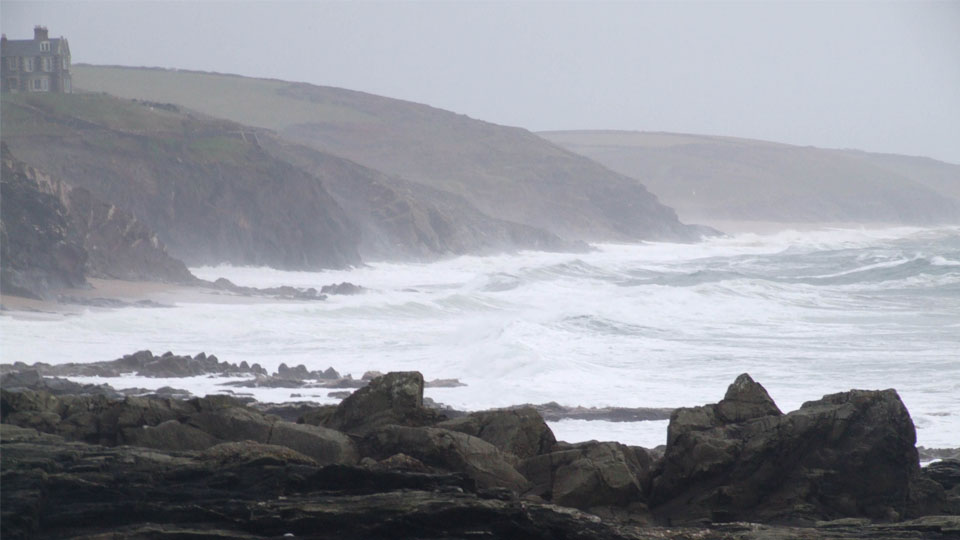
This month, contributing writer Jackie Harding shares a vivid journey from Porthleven to Wynwallow in stormy weather with Cornish Story. Read below to discover more.
As we set out from Porthleven on a wild and windy Sunday near Christmas, we were already looking forward to lunch at The Halzephron Inn, as famous for its smugglers as its food. Resisting the temptation to retreat before we began, we followed the road to the edge of Porthleven and as the houses dwindled and the road narrowed we clambered the craggy footpath to the cliff top. The sea below was wild and violent and the wind roared. I struggled to put one foot in front of another; fragments of poetry were blown half-forgotten around my mind.
Tennyson, Queen Victoria’s friend and one of the first tourists to take the train into Cornwall over Brunel’s bridge, recalled such a day: “the sea wind sang shrill, chill, with flakes of foam.”
Comforted by words in another place, like mariners cast ashore in Prospero’s vengeful storm we braved the mutinous winds and battled through the roaring between the green sea and the azured vault. Swinburne describes echoes of heraldic duels and wild souls crying in such a wind. In the clouds he saw shapes like dreams; my heroic energy was spent struggling to move forward as I pushed against the invisible wind using all my strength just to stay upright.
Under siege we held firmly onto our young son as he led us to a pill box perched twenty metres above the wild waves. A shingle reef, formed when the harbour was blasted, causes massive breakers that today attract surfers from around the world. In the past many ships were sea-swallowed here.
Daniel Defoe visited Cornwall around the time of writing Robinson Crusoe. In his letters he described the force and violence of the mighty ocean and also popularised the myth of a fierce and ravenous people eager for prey: the Cornish Wrecker. It is doubtful that Defoe, or the earlier travel writer, Richard Carew, who both described visits to this area, braved the surges at Loe Bar where vicious undercurrents make it treacherous for adventurers from sea or shore.
Loe Bar is a stretch of shingle bridging the sea and a natural lake. Across the bar Loe Pool is where Tennyson’s Knight, Bedivere, reluctantly cast Arthurs’s sword, Excalibur, and wondered as it was caught by an arm clothed in white. I saw no such ethereal wonders in the same still waters, unperturbed as I fought the storm in the air, windblown sand stinging my cheeks. Head down, skeletons of leaves and shells, feathers and bones, dried seaweed and grasses whirled past my feet; shadows of cormorants and gulls.
At the end of the beach heading south is a memorial to more than a hundred men who drowned here en-route to fight Napoleon. When HMS Anson was beached on a day like this two centuries ago, locals denied the wrecker imagined by Defoe and Du Maurier’s Jamaica Inn.
On this occasion, among the helpless locals trapped on the shoreline unable to reach the drowning men, was a boy, Henry Trengwine. The tragedy prompted the boy to dedicate his life to the invention of a rocket propelled life-saving apparatus, still used today. The fate of the bodies washed ashore and left to rot before hasty burial in unconsecrated ground led to an Act of Parliament the following year which made it a duty to provide a decent burial to those lost at sea.
Towering waves and the strongest gales drove us to a higher path, away from the cliff edge. The sun came through the clouds revealing blackberries that were never going to ripen. Bog cotton and furry caterpillars, a few lone yellow flowers and hardy campions kept us on track. The sun shone momentarily on the sea, silvery at rest.
Out of nowhere there appeared before us a vision complete with crenellations and a flag pole; a 1920s bungalow perched on the edge of the cliff, a tiny piece of suburbia huddled in the middle of the storm. The wind continued to bully me as the landscape became bleak once more.
I found myself in a country lane: the wind fell silent. Calm accompanied me to Wynwallow where there has been a settlement since pre-historic times. A dairy farm nestles by the sea; a herd of black and white cows and a bull with a ring in its nose waited placidly in the farmyard. The ancient church, squat in the shingle, is known as The Church of Storms because it has withstood the attack of the sea and the sand since, perhaps, a thousand years before Shakespeare imagined Prospero’s tempest. Not being ready to fade like his insubstantial pageant, needing more than dreams to sustain our bones, we finally reached the inn. Built in 1468 it has its own stories to tell.
Enjoyed reading this article? You can also read Jackie Harding’s article from last month by clicking here.
Photography by Rosie Beale who studied English at Truro and Penwith College. She now studies at Plymouth University. You can see more of her pictures of Cornwall on Flickr.
